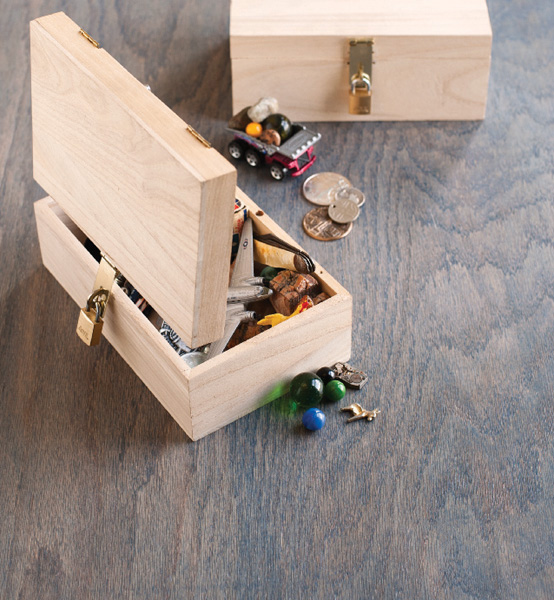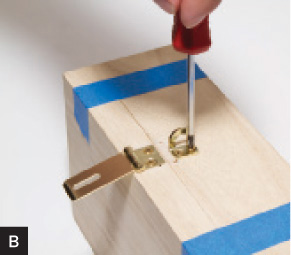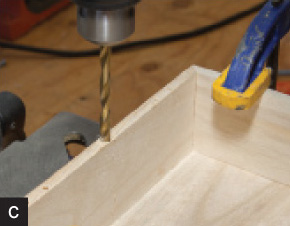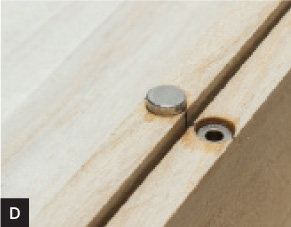PROJECTS PUZZLE TREASURE BOX
It’s easy to open this padlocked box, once you know the secret.
Puzzle Treasure Box

Gregory Hayes
![]() TIME: 1–2 HOUR
TIME: 1–2 HOUR ![]() COST: $
COST: $
Given as a gift, this puzzle box provides a few minutes of entertainment while the recipient solves the puzzle of how to open the locked box (which they’ve been given without a key). The obvious lock, hasp, and staple misdirect their attention from the secret: nonfunctional hinges and hidden magnets.
Leave the box in plain view on a desk, nightstand, or table to hold small items you’d like to keep inaccessible or unknown to the hoi polloi but readily available to the trusted few.
MATERIALS
» Box to be modified. See Step 1.
» Padlock, small
» Hasp and staple set such as Everbilt 2½" safety or Schlage decorative sets
» Wood screws, brass, flat-head Phillips, #4×3/8" (5)
» Felt pads or protective “feet” (4)
» Magnets, rare earth (NdFeB), ½" long × ¼" or 3/16" diameter (2) depending on your box’s wall thickness, Applied Magnets item #ND015 or #ND010, magnet4less.com
» Varnish or paint (optional)
TOOLS
» Drill and drill bits: 1/16", ¼", or 3/16" A drill press is recommended, though a handheld drill can also work if you’re very careful.
» Tape measure or ruler
» Pencil
» Glue
» Screwdrivers, small
» Safety glasses
» Brush (optional)
Paul Boon has been a scuba diver, welder, portrait painter, magician, truck loader, and sailboat crew member and has constructed three electric vehicles, started two successful small businesses, and been awarded two patents.
1. Obtain a suitable box.
For previous projects, I’ve purchased amazingly carved wooden boxes at import chain stores. This time I struck out, so I got boxes from Michaels and Big Lots for about $5. You might also try other craft stores, garage sales, secondhand stores, and flea markets.
Make sure the box is big enough to attractively mount the hasp you intend to use. I recommend you avoid boxes with the hinge screws exposed, because the puzzle aspect of the box can be bypassed if screws can be removed. Also, I prefer somewhat distressed wood — any damage I cause can go undetected.
2. Remove screws and glue the hinges.
Remove screws from one side of the hinges. Save the screws! Maybe you can use them to install the hasp.
Apply a drop of glue inside each hinge (Figure A) to hold the 2 leaves together. This prevents them from opening at an inopportune time and interfering with the closing of the box.
Gunther Kirsch
3. Apply finish (optional).
If your box is unfinished, now’s the time to paint or varnish it. Wait for everything to dry — don’t attempt to remove sawdust or fingerprints from tacky varnish.
4. Attach the hasp and staple.
Look for a location and orientation that please your artistic sensibilities. Mark the hasp and staple mounting holes with your pencil.
Drill 1/16" mounting holes that are less than ¼" deep. Mount your hasp and staple using the brass wood screws (Figure B).
5. Install magnets.
Mark an X for the magnet holes in the exact center of the hinged side of the lid and the opposing side of the box.
I prefer to use ¼" magnets because they require about 6lbs of force to pull apart. This makes it more difficult to find the secret method of opening. But before drilling ¼" holes, look carefully at the box panel you’ll be drilling into. If your panel is near ¼" thick, you might end up splitting it or drilling through it with a ¼" drill bit. In that case, downsize to 3/16". Whatever size you choose, drill the holes ¾" deep (Figure C).
Apply a drop of glue to each hole, then push the first magnet into its hole. Speaking with the (embarrassed) voice of experience, I advise you to allow the second magnet to attach to the one you’ve already installed. Then ensure that its opposite end is the one you push into the second hole.
I made one magnet stand 1/16" proud while the other is recessed 1/16" (Figure D).
6. Finishing touches.
Apply foot pads to protect your furniture. Put the lid in place, close the hasp, lock the lock, and throw away the key!
But wait — you’re not finished yet. My dear friend Dr. David Schultz tells me that gift puzzle boxes must always be filled with a treat or treasure. Although I settled for candy, you may choose gold doubloons, jewels, or the latest issue of MAKE! ![]()




